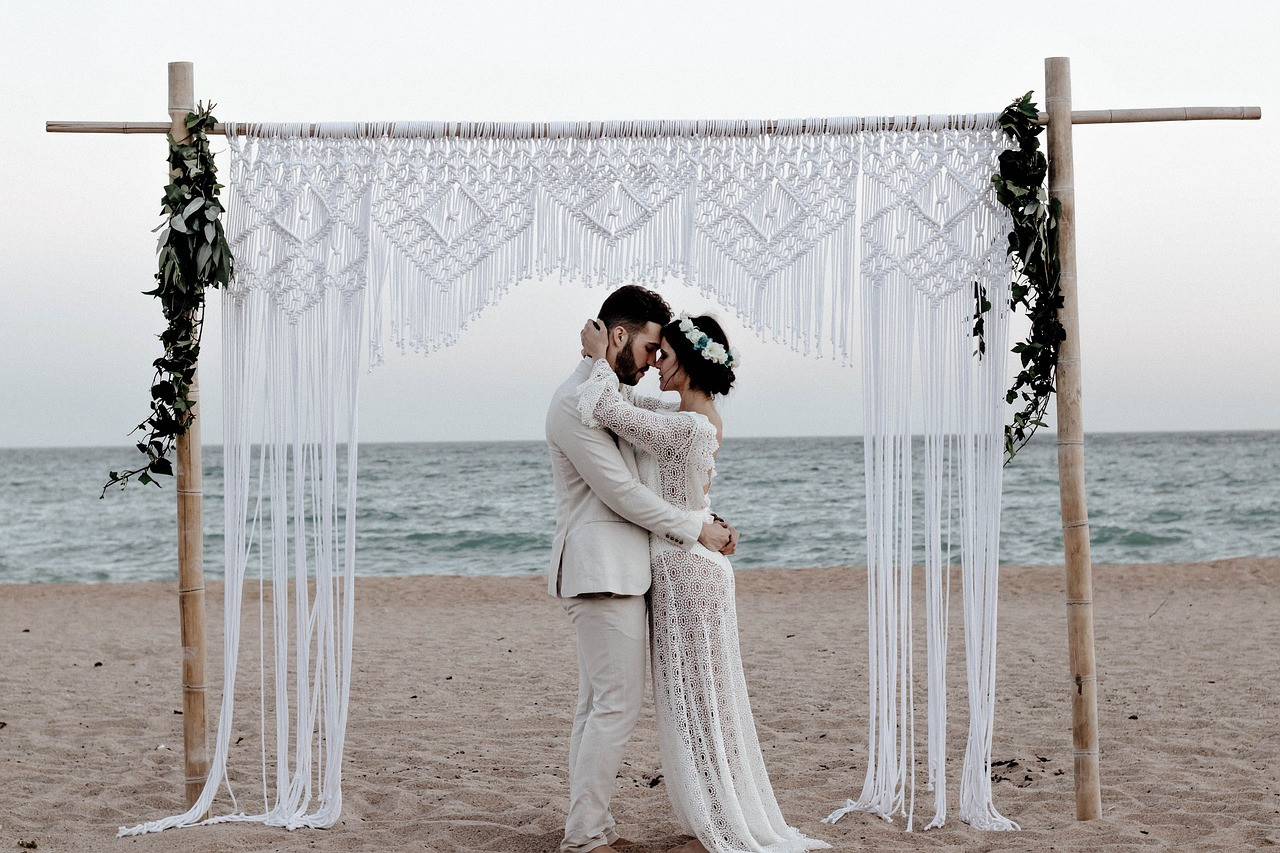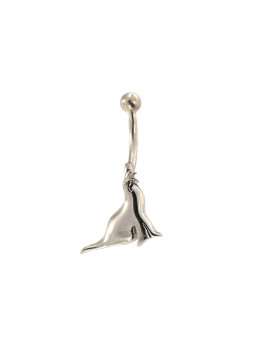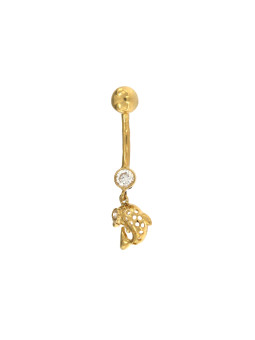Navel piercings: from piercing to choosing the perfect piece of jewelry

Increasingly popular in recent years navel piercing – this is the pinnacle of fashion and self-expression. With so many different piercing styles and piercing methods, choosing the right one can seem overwhelming. This article looks at the main factors to consider when choosing a piercing, and offers tips on how to care for the place of use. Follow these guidelines and enjoy your new belly button piercing with confidence!
Is the piercing procedure painful?
Navel piercings are done by professionals. First, the selected area will be cleaned, and if there is hair, the technician will most likely shave the area with a disposable razor. Then the selected puncture site is marked. Usually, the piercing is about 2-2.5 cm above the navel. The hole is made through the upper part of the umbilical cavity. This ensures that the lower part of the earring covers the top of the belly button. If your belly button is "protruding", it can slightly change the position of the piercing.
After that, a hole will be made with a hollow needle at the indicated place, and the jewelry will be inserted into it. Don't worry if you experience some bleeding, swelling or redness right after your piercing, this is completely normal and should go away quickly.
Navel piercings are not particularly painful, but they will still hurt - just like any other piercing. Granted, since the skin on your belly is fleshy, you can expect this piercing to be less painful than, say, a cartilage piercing.
Can I get more than one piercing at the same time?
The only limit to how many piercings you can get in one session is how much pain you can tolerate. You can technically get any combination of piercings, but it's recommended to start with one and see how it heals. If you plan to do several piercings, you should ask for local anesthesia.

6 the most popular types of navel piercings
Curved barbell
A common and most popular piece of jewelry is a curved weight that is slightly curved outwards to rest on the navel and usually better conforms to the natural shape of the body. This jewelry has a small bead on each end and one of them is adjustable/removable so you can change the accessory if you want.
Twister spiral
Bi-directionally curved spiral jewelry is fun to wear and makes a statement. The design of this earring is said to put less stress on the navel area.
Captive bead
Size matters for this piece of jewelry. Sizes 14 and 16 are commonly offered for this style, which "hug" the navel area and extend outwards, so the side of the earring is visible.
Reverse / Top-down
Those who use this style usually display the larger part of the jewelry above the belly button and the smaller part inside it. Heavier design elements will be placed on top, but the advantage of this style is that you can wear the piece however you want, hence the name.
Dangle
If you're going to show off your belly button piercing, dangling jewelry is the way to go. This style usually features a curved bar, so there are many options and designs, such as jewels or pendants on the tip of the earring.
Non-dangle
This smaller style is perfect for those who lead active lives or don't feel the need to constantly show off their belly button piercing. Dangle jewelry fits closer to the navel and usually comes in a drop, loop, or curved weight shape.
The best materials for body jewelers
Surgical stainless steel is generally the safest metal, because it does not irritate or cause allergies.If you want to avoid the possible negative effects of surgical steel or if you know that you are allergic to nickel, it is the best choice surgical titanium.
If you prefer gold for overall aesthetics and appearance, feel free to choose this metal for your new earring. The safest is 14 carat gold, and the color - red, yellow or white - choose according to your taste or skin tone. Ask yourself the following questions:
- Does this jewelry brighten my skin tone?
- Do I look paler or brighter with this gold shade?
- If I tan, will the gold tone I choose still complement my skin tone?
- Does gold bring out tones I don't want to see (like a yellowish skin tone)?
The ideal earring size
The earring should be the ideal length for you. A tip that is too short can pinch the skin and cause pain. And too long - to hang or get tangled in clothes.
Measure the length from the top of the belly button to the piercing hole. This will give you an approximate earring size you should choose.1,6 mm (14) is the most common.

How to care for a pierced navel?
Post-procedure care is an important part of any type of piercing. On average, a belly button piercing takes about three to six months to heal.
For the first 1-2 weeks after piercing, it is recommended to soak it in salt twice a day. You can use a homemade saline solution or an over-the-counter post-piercing spray (available online or at most piercing studios). To make your own solution, follow these instructions:
1. Mix ¼ teaspoon of salt with 1 cup of sterilized water. To sterilize water, boil it for about five minutes and let it cool.
2. Fill a small cup or container with the solution (about half full). Take the cup and press it against the belly button (so that the cup fits tightly against the skin). Let the piercing soak for about five minutes. After soaking, gently wipe off excess dirt with a tissue or cotton ball.
In addition, you should spray the piercing with saline solution 4-6 times a day. The purpose of spraying is to keep the piercing clean of dirt and/or debris, as well as to provide hydration to the surrounding skin.
It is not recommended to wash the navel with soap for at least the first few months after piercing. Washing with soap can dry out the skin and even crack it (making it more likely to become infected).
After how long can you start wearing heavier earrings?
It is recommended to wait three to six months after the piercing before changing the piercing. This is because the belly button will have enough time to recover (it will be much easier to change the jewelry). Once the belly button has healed, you can wear any type of piercing, including danglers.
How to change an earring?
You can effectively change your belly button piercing yourself, but before doing so, you need to be absolutely sure that the piercing is healed. As mentioned, while the usual healing period is three to six months, it can take up to a year. For this reason, most stylists advise waiting a full year before changing the piercing, but if you are impatient, it is best to return to the stylist and have the piercing changed in the studio.
The top of the jewelry is usually unscrewed, so it can be unscrewed and easily replaced in the same way. The only thing to remember is to always wash your hands before touching the piercing in any way to avoid irritating it and transferring bacteria.
Can pregnant women wear navel piercings?
Yes! Just because you're pregnant doesn't mean you can't wear a belly button piercing. There are a few different options you can choose from, the first being getting a piercing made specifically for pregnant women. Such jewelry is usually made of synthetic material and is adjustable in size. You can use them even after you have a baby (after reducing the synthetic stem).
Another option is to buy several earrings of different lengths and change them as the pregnancy progresses.

Infections of the navel piercing
It is normal to feel a little irritation around the belly button after getting it pierced. The skin around the piercing may become red and a clear/white discharge may appear. These symptoms are normal and do not indicate an infection. However, if the discharge is not clear/white or red streaks appear on the skin, there may be cause for concern.
A slightly more common problem that can lead to infection is that the piercing is too tight. Jewelry that is too small can lead to hypertrophic scarring and hypergranulation. If this happens, you need to see a piercer as soon as possible and tell them that you need a bigger piercing. The only way to solve the problem of hypergranulation is to reduce the excessive pressure caused by a tight piercing. If you do not take care of this problem, you can even develop an unpleasant infection called necrosis, which causes the tissue to die.
If you get an infection in the piercing, you need to see a doctor as soon as possible. Belly piercing infections are usually treated with antibiotics. It's important to finish the full course of antibiotics (ie don't stop just because the puncture looks a little better). If you stop taking the prescribed antibiotics before completing the course of treatment, the infection may come back even stronger than before.













Leave a comment